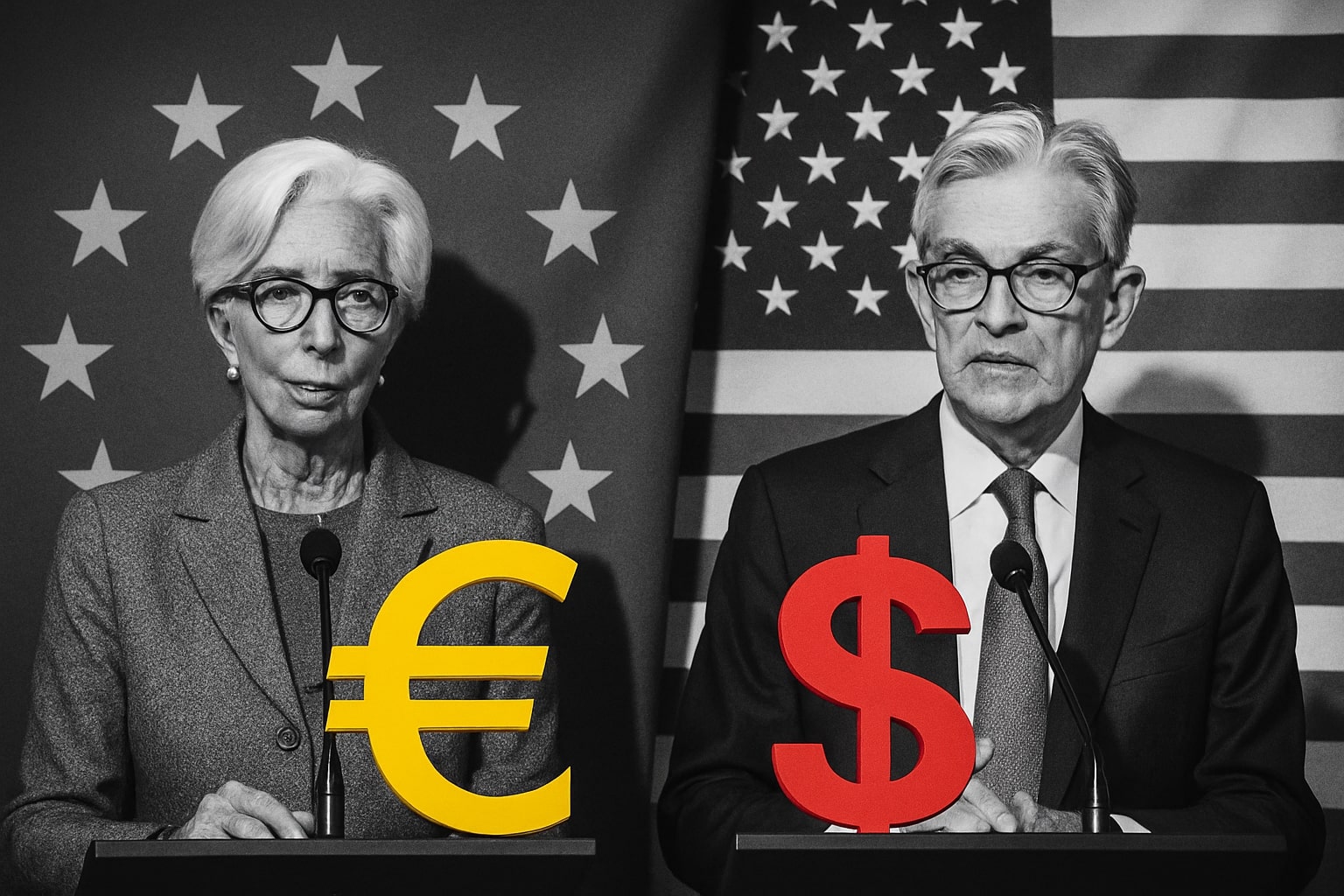
EUR/USD Price Forecast - Euro to Dollar at 1.1566: Pairs Holds Fragile Recovery as Fed Paralysis and U.S. Shutdown
After sinking to 1.1467, EUR/USD steadies near 1.1566 as missing U.S. data, Fed indecision, and ECB recession fears lock the pair in a 1.1445–1.1680 range | That's TradingNEWS
EUR/USD Holds 1.1566 After U.S. Data Blackout, Fed Confusion, and European Stagnation Cloud Direction
The EUR/USD pair sits around 1.1566 in late New York trading, recovering modestly from last week’s low of 1.1467, which marked its weakest level since early August. The rebound followed a two-day rally that lifted the pair above the 1.1550 handle, but the tone remains defensive as markets struggle with missing U.S. economic data, confusion around Federal Reserve policy, and deepening signs of stagnation in the Euro Area. After dropping from 1.1730 in mid-October when the Fed cut rates by 25 basis points but failed to signal any clear direction for December, the pair continues to trade inside a compressed range dominated by risk aversion and speculative short-covering.
U.S. Fiscal Gridlock and Data Void Paralyze Monetary Expectations
The ongoing U.S. government shutdown, now stretching past six weeks, has halted the release of Non-Farm Payrolls and CPI data for two consecutive months, leaving traders without official confirmation of growth or inflation trends. This vacuum has paralyzed the Federal Reserve’s guidance and eroded visibility across all dollar-denominated assets. In October the Fed’s statement that it was “data-dependent” instantly became meaningless, forcing money-market traders to price in only a 30 percent probability of another rate cut in December—down from nearly 70 percent before the blackout.
At the same time, corporate America is flashing warning signals: large-scale layoffs at Amazon (NASDAQ: AMZN), UPS (NYSE: UPS), and regional lenders have dented confidence in labor resilience. The absence of official metrics leaves investors relying on alternative datasets that show hiring momentum collapsing to its weakest pace since 2020. This deteriorating U.S. backdrop has weakened the USD Index (DXY) by roughly 1.1 percent over the week, but the euro has struggled to capitalize because of its own growth constraints.
Eurozone Faces Stagnation While ECB Loses Narrative Control
On the European side, ECB President Christine Lagarde’s tone has shifted sharply over recent meetings. In early September she declared that “the disinflationary process is over,” implying the end of rate cuts, but by late October her tone cooled as industrial production and consumer spending data showed contraction in Germany (−0.4 percent m/m) and France (−0.2 percent). The eurozone composite PMI at 47.9 confirms recessionary momentum.
Investors now doubt whether the ECB can hold its deposit rate at 3.75 percent beyond Q1 2026 without risking deflation. The sharp divergence between the ECB’s cautious optimism and hard data has left the euro exposed to yield-differential pressure. The German 10-year Bund yields 1.92 percent, compared with the U.S. 10-year Treasury’s 4.55 percent, widening the carry spread to a three-year extreme of 263 basis points. That gap continues to anchor EUR/USD below 1.1600 despite dollar weakness elsewhere.
Technical Picture: 1.1500 Support Defines Market Psychology
The 1.1500 level is again the magnetic axis of the pair. It has acted as a pivot for nearly a decade—first as resistance during 2018-2020, then as support after the 2022 energy-crisis rebound. Last week’s dip to 1.1467 triggered heavy buying by European institutions that viewed the level as oversold territory, yet volume analysis shows only short-term positioning rather than genuine reversal flows.
The pair remains locked in a sequence of lower highs and lower lows since the Fed’s September 17 decision. The 50-day moving average at 1.1628 caps recovery attempts, while the 200-day average near 1.1370 defines the long-term base. Daily RSI sits near 42, showing mild recovery but no strong momentum. For bulls to regain control, EUR/USD must close above 1.1620, which would open the way toward 1.1680–1.1730; failure would re-invite sellers targeting 1.1450 and possibly 1.1380. The speculative range for the coming week stands between 1.1445 and 1.1680.
Market Liquidity and Institutional Behavior
Institutional desks describe the current market as “directionless with thinning liquidity.” Options volumes have dropped 27 percent m/m, while open interest in EUR/USD futures on the CME is down to 178,000 contracts, the lowest since 2022. Large banks are running flatter books, signaling unwillingness to hold overnight risk until Washington ends the data blackout. Algorithmic strategies dominate intraday price action, producing frequent 20–40 pip whipsaws around key pivot levels.
Inter-bank sources note that European corporate exporters have used the bounce above 1.1550 to re-hedge dollar receivables, creating a layer of supply that limits upside extension. U.S. hedge funds remain net-long USD futures by $12.4 billion, suggesting that macro positioning still favors dollar strength once data resumes.
Geopolitical Pressure Points and Safe-Haven Flows
Geopolitical risk is another layer restraining euro recovery. The escalating trade confrontation between Washington and Beijing, combined with renewed tariff rhetoric from President Trump, has re-inflamed concerns about European export exposure. The eurozone’s dependence on Chinese demand—roughly €230 billion in annual exports—makes it vulnerable to any slowdown triggered by new U.S. restrictions.
Energy markets also weigh on sentiment. Brent Crude Oil (BZ=F) trades near $63.10, down from $71 last month, easing inflation pressure but squeezing the profit margins of European refiners and commodity-linked equities. The Euro Stoxx 50 Index has fallen 1.3 percent M/M, reflecting caution that directly filters into EUR/USD through cross-asset correlations.
Meanwhile, investors seeking safety have poured capital into Swiss franc and Japanese yen, leaving the euro underperforming within the G10 complex. The EUR/CHF cross has slipped to 0.9550, the weakest since May, indicating that capital preservation remains the dominant mindset across continental Europe.
U.S. Policy Paralysis Versus European Fatigue: Which Side Blinks First?
The policy divergence that once defined this pair has narrowed to near paralysis on both sides. The Fed’s inability to communicate a roadmap for 2026 contrasts with the ECB’s hesitance to recognize a looming recession. Both institutions are effectively frozen by political and fiscal constraints: the Fed by Congress’s shutdown, the ECB by fragmentation inside the eurozone. Traders are left pricing relative stagnation, not growth differential.
Nevertheless, relative real yields still favor the dollar. Even at current inflation prints—U.S. core PCE 2.3 percent versus Eurozone core HICP 1.8 percent—the real yield premium is +1.8 percent for the U.S. That structural advantage keeps speculative accounts biased to the downside in EUR/USD until there is evidence of renewed European growth.
Read More
-
ARTY ETF (NYSEARCA:ARTY) Climbs To $48.18 As AI Boom Pushes Assets Past $2B
09.11.2025 · TradingNEWS ArchiveStocks
-
XRP ETFs XRPI And XRPR Rally To $13.98 And $19.46 As SEC Countdown Sparks Institutional Frenzy
09.11.2025 · TradingNEWS ArchiveCrypto
-
Natural Gas Price (NG=F) Falls to $4.31 as Record U.S. Output and Unseasonably Warm Weather Crush Demand
09.11.2025 · TradingNEWS ArchiveCommodities
-
USD/JPY Price Forecast - Dollar to Yen (¥153.41) Dips from 8-Month High as Fed Cut Odds Hit 70%
09.11.2025 · TradingNEWS ArchiveForex
Short-Term Scenarios and Price Triggers
If EUR/USD sustains daily closes above 1.1550, intraday algorithms could extend the corrective rally toward 1.1600–1.1620. A break above 1.1630 would target the 1.1680 Fibonacci zone, derived from the May–September swing. Conversely, renewed selling below 1.1500 would expose 1.1440 and possibly 1.1370, levels that coincide with March’s pivot low. Volatility remains subdued at 6.2 percent implied, the lowest since July, suggesting an explosive move once data resumes.
Options desks report concentrated put open interest at 1.1450 and calls at 1.1650, creating a compression band that could release sharply after the November 15 Fed communication window.
Market Sentiment and Trader Positioning
Retail trading data show 62 percent of positions remain net-long EUR/USD, a contrarian bearish signal since the start of October. Professional flow desks note that the rally toward 1.1560–1.1570 was largely profit-taking from short positions initiated near 1.1700, not genuine accumulation. Until fundamental catalysts shift, the path of least resistance remains sideways to lower.
The CFTC’s Commitments of Traders report from the last available week before the shutdown showed euro net-long contracts shrinking to 43,000 from 58,000, confirming sentiment deterioration even before official data ceased.
Final Assessment: EUR/USD Bias Remains Bearish with Defensive Support
Considering all available metrics—macroeconomic divergence, missing U.S. data, European stagnation, and persistent carry disadvantage—the structure of EUR/USD points to continued downward bias. The pair’s inability to hold gains above 1.1600 despite dollar softness elsewhere underscores weak euro demand. Only a decisive resolution of the U.S. shutdown or a surprise ECB stimulus could trigger a sustainable reversal.
Until such catalysts emerge, the practical trading stance remains SELL rallies with tight risk control. Immediate resistance stands at 1.1620, stronger at 1.1680, and support anchored at 1.1500–1.1450. The broader forecast range of 1.1445 to 1.1680 defines the near-term battlefield. The bias is Bearish, with downside risk toward 1.1380 if macro paralysis continues into December.



















